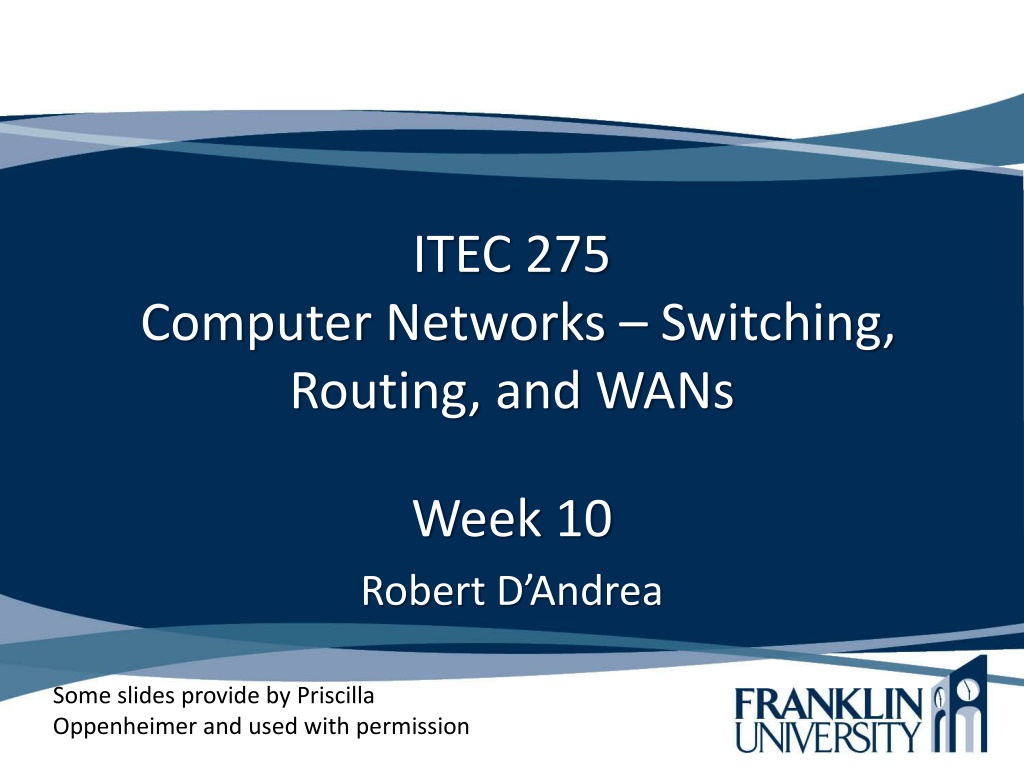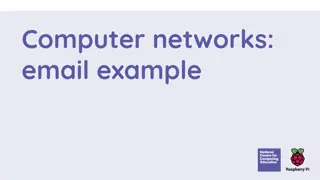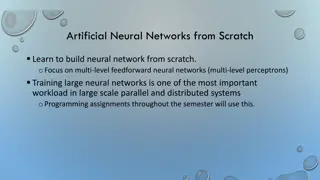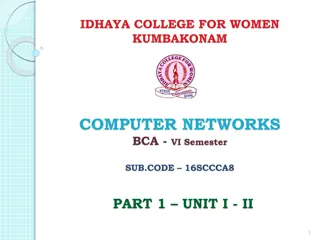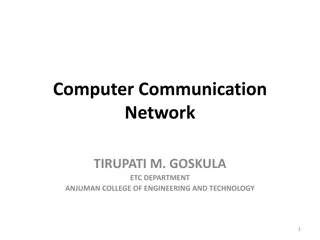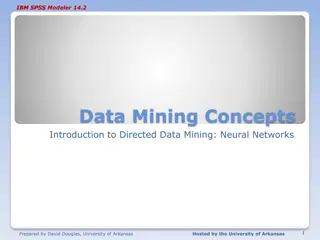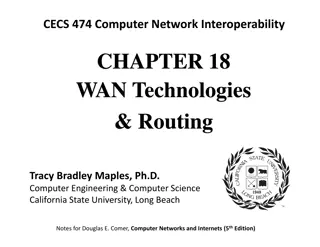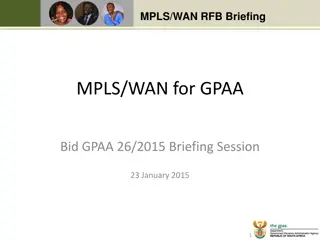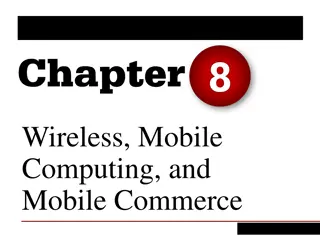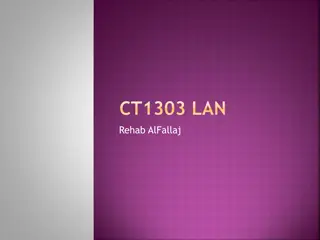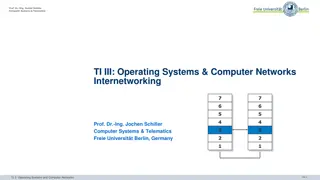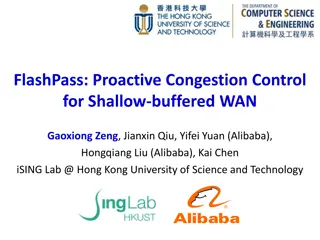Computer Networks and WAN Technologies Overview
This presentation covers a range of topics related to computer networks and wide area networks (WANs) including PPP, cable modems, DSL, leased lines, SONET, Frame Relay, Metro Ethernet, ATM, selection criteria for WAN service providers, enterprise technologies and devices, remote access networks, and selection criteria based on business requirements, constraints, technical goals, and more.
Download Presentation

Please find below an Image/Link to download the presentation.
The content on the website is provided AS IS for your information and personal use only. It may not be sold, licensed, or shared on other websites without obtaining consent from the author.If you encounter any issues during the download, it is possible that the publisher has removed the file from their server.
You are allowed to download the files provided on this website for personal or commercial use, subject to the condition that they are used lawfully. All files are the property of their respective owners.
The content on the website is provided AS IS for your information and personal use only. It may not be sold, licensed, or shared on other websites without obtaining consent from the author.
E N D
Presentation Transcript
ITEC 275 Computer Networks Switching, Routing, and WANs Week 10 Robert D Andrea Some slides provide by Priscilla Oppenheimer and used with permission
Agenda Learning Activities PPP Cable Modems and DSL Leased Lines, SONET, Frame Relay, Metro Ethernet, ATM Selecting a WAN Service Provider
Enterprise Technologies and Devices Remote access networks Wide area networks (WANs) Devices End user remote access devices Central site remote access devices VPN concentrators Routers
Selection Criteria Business requirements and constraints Cost Technical goals Bandwidth requirements QoS requirements Network topology Traffic flow and load Etc.
Remote Access Technologies The Point-to-Point Protocol (PPP) Integrated Services Digital Network (ISDN) Cable modems Digital Subscriber Line (DSL)
Point-to-Point Protocol (PPP) PPP is used with synchronous, asynchronous, dial-up, and ISDN links Defines encapsulation scheme for transport of different network-layer protocols Supports authentication: Password Authentication Protocol (PAP) Challenge Handshake Authentication Protocol (CHAP). CHAP more secure than PAP
Point-to-Point Protocol (PPP) The Internet Engineering Task Force (IETF) developed PPP as a standard data link layer protocol for transporting various protocols across serial, point-to-point links. PPP can be used to create point-to-point links between different vendor s equipment. PPP uses a Network Control Protocol field in the Data Link header to identify the Network layer protocol.
Point-to-Point Protocol (PPP) PPP can be used to connect a single remote user to a central office, or to connect a remote office with many users to a central office. PPP is a data-link protocol that can be used over either asynchronous serial (dial-up) or synchronous serial (ISDN) media and that uses the LCP (Link Control Protocol) to build and maintain data-link connections.
PPP Layers Network Control Protocol (NCP) Link Control Protocol (LCP) Encapsulation based on High-Level Data-Link Control Protocol (HDLC) Physical Layer
PPP Point-to-Point (PPP) is a data link protocol commonly used in establishing a direct connection between two networking nodes. It provides connection authentication, transmission authentication, and compression. PPP is used over many types of physical networks including serial cable, phone line, trunk line, cellular telephone, and fiber optic links such as SONET. PPP is also used over the Internet access connections (broadband).
Multilink MPPP An ordinary dial-up modem connection to the Internet through an Internet service provider (ISP) usually uses PPP as its wide area network (WAN) data-link protocol, but there are times when the 56-Kbps speed provided by V.90 modems is insufficient. MPPP allows multiple physical dial-up links to be inverse multiplexed together to form a single high-bandwidth logical PPP connection between the dial-up client and the ISP. MPPP works by ordering the data frames from the client across the multiple PPP channels and recombining them at the ISP s termination point, and vice versa.
Multilink MPPP MPPP defines protocols for splitting the data stream into PPP packets, sequencing the packets, transmitting them over separate logical data links, and then recombining them at the receiving station.
Multilink MPPP Inverse multiplexing speeds up data transmission by dividing a data stream into multiple concurrent streams that are transmitted at the same time across separate channels (such as a T-1 or E-1 lines) and are then reconstructed at the other end back into the original data stream. Just the reverse of ordinary multiplexing , which combines multiple signals into a single signal, inverse multiplexing is a technique commonly used where data in a high-speed local area network ( LAN ) flows back and forth into a wide area network ( WAN ) across the "bottleneck" of a slower line such as a T-1 (1.544 Mbps ).
Multilink MPPP Various multiplexing methods are possible in terms of the channel bandwidth and time, and the signal, in particular the frequency, phase or time. The two basic methods are: Frequency Division Multiplexing (FDM) is derived from AM techniques in which the signals occupy the same physical line but in different frequency bands. Each signal occupies its own specific band of frequencies all the time, i.e. the messages share the channel bandwidth.
Multilink MPPP Time Division Multiplexing (TDM ) is derived from sampling techniques in which messages occupy all the channel bandwidth but for short time intervals of time, i.e. the messages share the channel time.
Multilink MPPP Add support for channel aggregation to PPP. Channel aggregation can be used for load sharing and providing extra bandwidth. With channel aggregation, a device can automatically bring up additional channels as bandwidth requirements increase. MPPP ensures that packets arrive in order at the receiving device.
Multi-chassis MPPP Cisco enhancement to MPPP. Allows WAN administrator to group multiple access servers into a single stack group. User traffic can be split and reassembled across multiple access servers in the stack group.
Multi-chassis Multilink PPP Stack group ISDN Offload server Analog
CHAP CHAP provides a three-way hand-shake. Provides protection by verifying a remote node with a three-way hand shake and a variable challenge value that is unique and unpredictable.
CHAP Remote Node Access Server Connect Database of Users and Passwords Challenge Name: 760_1 Password: sfy45 Name: 760_1 Password: sfy45 Hashed Response Name: 760_2 Password: kingsford Accept or Deny
ISDN Digital data-transport service offered by regional telephone carriers (telcos) Circuit-switched service that carries voice and data. ISDN is a set of digital services that transmit voice and data over existing phone lines. Cost-effective remote-access solution for telecommuters and remote offices Cost of an ISDN circuit is usually based on a monthly fee plus usage time Good choice as a backup link for another type of link, for example, Frame Relay Channel aggregation is popular with ISDN links.
ISDN Interfaces Basic Rate Interface (BRI) } 64 Kbps 64 Kbps 2B 144 Kbps D 16 Kbps Primary Rate Interface (PRI) 1.544 Mbps in U.S. 64 Kbps 64 Kbps} 23B or 30B 2.048 Mbps in Europe D
ISDN Components R S/T U Non-ISDN device (TE2) To ISDN service NT1 TA 4-wire circuit 2-wire circuit S/T U ISDN device (TE1) To ISDN service NT1 S T U ISDN device (TE1) To ISDN service NT1 NT2 U ISDN device (TE1) with built-in NT1 To ISDN service NT1
Cable Modem Service Operates over the coax cable used by cable TV Much faster than analog modems, and usually much faster than ISDN (depending on how many users share the cable) 25 to 50 Mbps downstream from the head end 2 to 3 Mbps upstream from end users Standard = Data Over Cable Service Interface Specification (DOCSIS)
Cable Modem Service Coax Cable does not require dial-up. Cable modem operates more like a LAN. Cable-network providers off hybrid fiber/coax (HFC) systems that connect CATV networks to the service provider s high-speed fiber-optic network. HFC systems allow connections of home PCs and small LANs to high-speed access to the Internet or to a private network using VPN.
Cable Modem Service CATV (Cable Modem Termination System) provides high-speed connectivity for cable modems. Cable modem solution for remote users or remote offices is the sharing a single cable and the types of applications they use.
DSL High-speed digital data traffic over ordinary telephone wires Sophisticated modulation schemes mean higher speeds than ISDN Speeds range from 1.544 to 9 Mbps Actual bandwidth depends on type of DSL service, DSL modem, and many physical-layer factors Symmetric communication (SDSL) traffic flow travels at the same speed up to 1.544 Mbps. Asymmetric DSL (ADSL) very popular Downstream faster than upstream
PPP and ADSL Asymmetric DSL (ADSL) uses two popular PPP implementations. PPP and ATM (PPPoA) the CPE acts as an Ethernet-to-WAN router and the PPP session is established between the CPE and Layer 3 access concentrator in the service provider s network. PPP and Ethernet (PPPoE) the CPE acts as an Ethernet-to-WAN bridge.
PPP and ADSL PPP and Ethernet (PPPoE) the CPE acts as an Ethernet-to-WAN bridge. The client initiates a PPP session by encapsulating PPP frames in MAC frames and then bridging the frames over ATM/DSL to a gateway router at the service provider. From that point, the PPP session can be established, authenticated, and achieved. The client receives its IP address from the service provider, using PPP negotiation.
PPP and ADSL Point-To-Point Protocol (PPP) Vedio: https://www.youtube.com/watch?v=Oq0Si0WWHdM
Provisioning WAN Bandwidth A critical network design is considering capacity requirements. Selecting the right amount of capacity for current and future needs. Provisioning requires an analysis of traffic flows, and analysis of scalability goals.
WAN Technologies Leased lines Synchronous Optical Network (SONET) Frame Relay Asynchronous Transfer Mode (ATM)
Leased Lines Dedicated digital, copper circuits that a customer leases from a carrier for a predetermined amount of time, usually for months or years Speeds range from 64 Kbps to 45 Mbps Enterprises use leased lines for both voice and data traffic
Leased Lines Dedicated connection or Point-to-Point connection. Pre-established WAN communications path from the CPE, through the DCE switch, to the CPE of the remote site, allowing DTE networks to communicate at any time with no setup procedure before transmitting data.
Digital Signal (DS) A channel in the NADH (North American Digital Hierarchy) is called a digital signal (DS). Digital signals are multiplexed together to form high-speed WAN circuits. DS-1 and DS-3 are the most commonly used capacities.
The North American Digital Hierarchy
Synchronous Optical Network (SONET) Physical-layer specification for high-speed synchronous transmission of packets or cells over fiber-optic cabling Service providers and carriers make wide use of SONET in their internal networks Gaining popularity within private networks
Synchronous Optical Network (SONET) Goals of SONET and SDH - Define higher speeds than the ones used by the NADH. - Support efficient multiplexing and de-multiplexing of individual signals. With SONET, it is easy to isolate one channel from a multiplexed circuit. With plesiochronous systems, like NADH and European E system, isolating one channel is more difficult.
Synchronous Optical Network (SONET) Terminating multiplexers (implemented in switches and routers) provide user access to the SONET network. Terminating multiplexers convert electrical interfaces into optical signals and multiplex multiple payloads into STS-N signals required for optical transport.
SONET Optical Carrier (OC) Levels aka Synchronous Transport Signal (STS) Levels STS Rate OC Level Speed STS-1 STS-3 STS-12 STS-24 STS-48 STS-96 STS-192 OC-1 OC-3 OC-12 OC-24 OC-48 OC-96 OC-192 51.84 Mbps 155.52 Mbps 622.08 Mbps 1.244 Gbps 2.488 Gbps 4.976 Gbps 9.952 Gbps
Typical SONET Topology SONET Multiplexer Backup Pair Working Pair
Frame Relay Industry-standard data-link-layer protocol for transporting traffic across wide-area virtual circuits Optimized for efficiency on circuits with low error rates Attractively-priced in most parts of the world Carriers agree to forward traffic at a Committed Information Rate (CIR)
Frame Relay and X.25 X.25 was optimized for excellent reliability on physical circuits with high error rates. X.25 was more complex to implement than Frame Relay. X.25 works at the physical, data link, and network layers. X.25 allows computers on different public networks (CompuServe, TCP/IP) to communicate through an intermediary computer at the network layer level.
Frame Relay (continued) To Router B: DLCI 100 To Router A: DLCI 200 Router A Router B Virtual Circuit (VC)
Virtual Circuit What is a virtual circuit? OSI model used in example. TCP takes large blocks of information from an application and breaks them into segments. It numbers and sequences each segment so that the destination s TCP protocol can put the segments back into the order the application intended. After the segments are sent, TCP (trans host) waits for an acknowledgment of the receiving end s TCP virtual circuit session, retransmitting those that aren t acknowledged. Before a transmission occurs, a host sends segments down the OSI model, the sender s TC protocol contacts the destination s TCP protocol to establish a connection. This type of connection is considered to be connection-oriented. UDP is connectionless connection.
Frame Relay Hub-and-Spoke Uses Subinterfaces hostname central site Central-Site Router interface serial 0 encapsulation frame-relay interface serial 0.1 DLCI 100 DLCI 200 ip address 10.0.1.1 255.255.255.0 frame-relay interface-dlci 100 interface serial 0.2 ip address 10.0.2.1 255.255.255.0 frame-relay interface-dlci 200
Frame Relay Frame Relay Video: https://www.youtube.com/watch?v=GCCpEM2CoGY
Split Horizon A routing technique in which information about routes is prevented from exiting the router interface through which that information was received. Split horizon updates are useful in preventing routing loops. that is associated with a physical interface. The central site could have five PPP sub-interfaces defined, each communicating with one of the remotes sites. With this solution, the central site router applies the split horizon rule based on logical sub-interfaces, instead of the physical interface, and includes remote sites in the routing updates it sends out the WAN interface. Use a sub-interfaces. This is a logical interface
Split Horizon Split horizon can be eliminated using full mesh design with physical circuits between each site.
